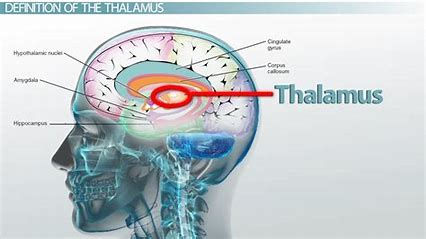Thalamic Stroke!
- Jules D
- May 5, 2024
- 3 min read
Since this month is all about Stroke Awareness & Prevention, I figured it would be great to talk about strokes, risk factors, and how you know you've had one!! The next four posts we will dive into all of that good stuff. I definitely want to touch on the strokes I've had. I have two neurology appointments this week, so I might come back and edit some things to add. I'll be sure to make that note at the end and BOLD all of my additions! Ready...set...let's go!!

The thalamus is about the size of a walnut and sits deep in the center of the brain. It has two small halves and serves several roles.
All of the body's senses, except smell, are connected to the thalamus. This small structure transfers information from the senses to the brain.
Additionally, the thalamus helps regulate:
arousal
pain response
language
cognition
mood
motivation
A thalamic stroke occurs when a small blood vessel serving the thalamus becomes blocked. A blood clot or atherosclerotic plaque may cause the blockage. Tissue begins to die, which may lead to long-term brain damage, disability, or death.
A thalamic stroke is a type of lacunar stroke, which refers to a stroke in a deep part of your brain. Thalamic strokes occur in your thalamus, a small but important part of your brain. It’s involved in many crucial aspects of your everyday life, including speech, memory, balance, motivation, and sensations of physical touch and pain.
Depending on the part of the thalamus affected, a thalamic stroke may cause various symptoms, including:
absent or abnormal sensation on one side of the face, arm, and leg
sensory changes involving:
touch
pain
temperature
pressure
vision
hearing
taste
mild or moderate weakness on one side of the body
difficulties with movement or maintaining balance
speech difficulties
vision loss or disturbance
sleep disturbances
lack of interest or enthusiasm
changes in attention span
memory loss
thalamic pain, also called central pain syndrome, which involves burning or freezing sensations in addition to intense pain, usually in the head, arms, or legs
Following a thalamic stroke, people may experience the following secondary effects:
Speech and language difficulties
The thalamus is involved in various cognitive and motor functions, including speech. Following a thalamic stroke, a person may lose the ability to understand language and speech. Sometimes this is temporary and improves.
Changes in behavior and mood
Since the thalamus helps regulate mood and motivation, behavioral and mood changes are common following a thalamic stroke.
Small vessel disease causes lacunar strokes, and having multiple lacunar strokes can contribute to vascular dementia. Vascular dementia may develop when strokes affect several brain areas.
The main effect of thalamic stroke is diminished sensation. This may affect how a person uses their body or objects. A decrease in sensation can also lead to injuries and unawareness of pain.
Everyone recovers from strokes differently. Depending on how severe the stroke was, you may be left with permanent:
memory loss
loss of sensation
speech and language problems
memory problems
However, these lingering symptoms may improve over time with rehabilitation. Remember, having a stroke increases your risk of having another one, so it’s very important to stick to the plan you and your doctor come up with to reduce your risks, whether it involves medication, therapy, lifestyle changes, or a combination of all three.




Comments